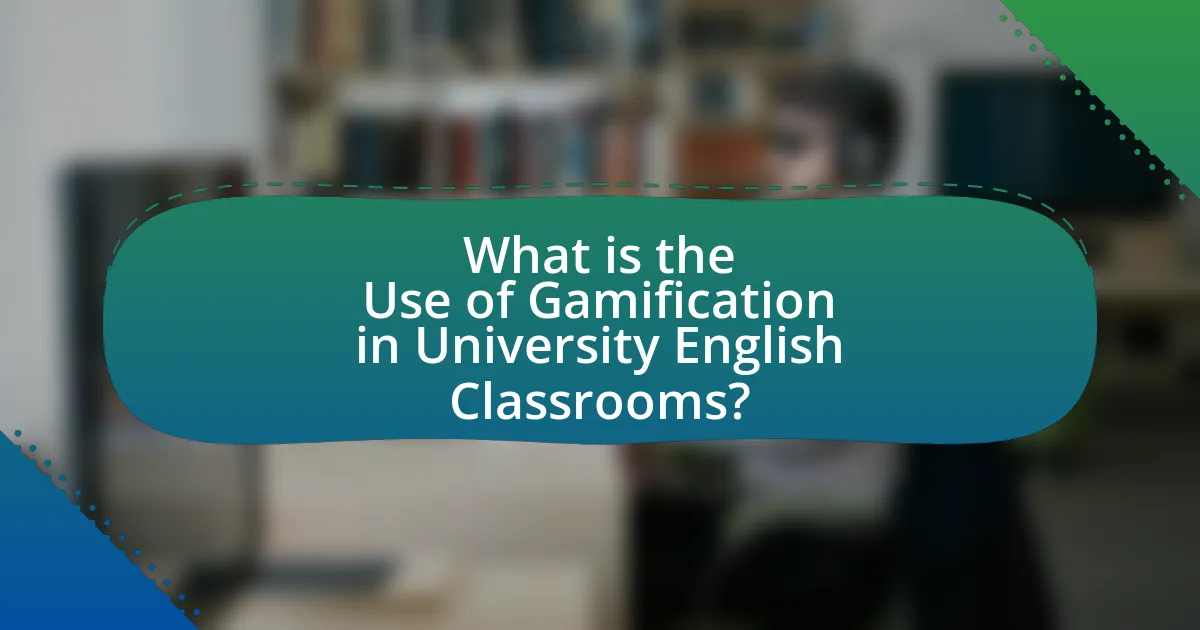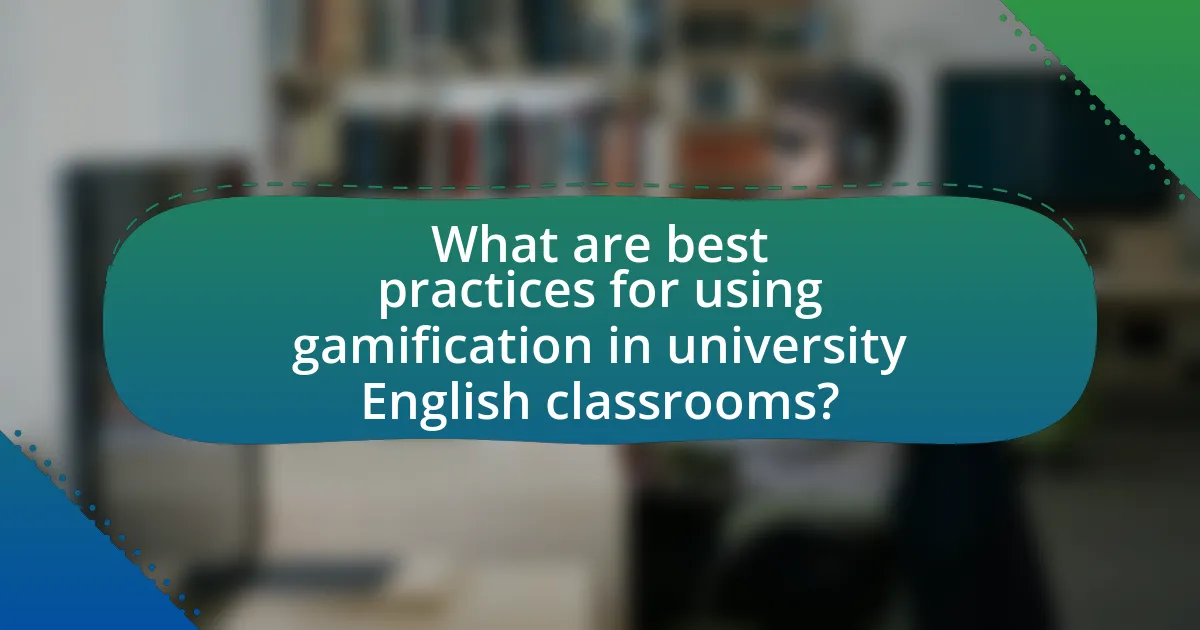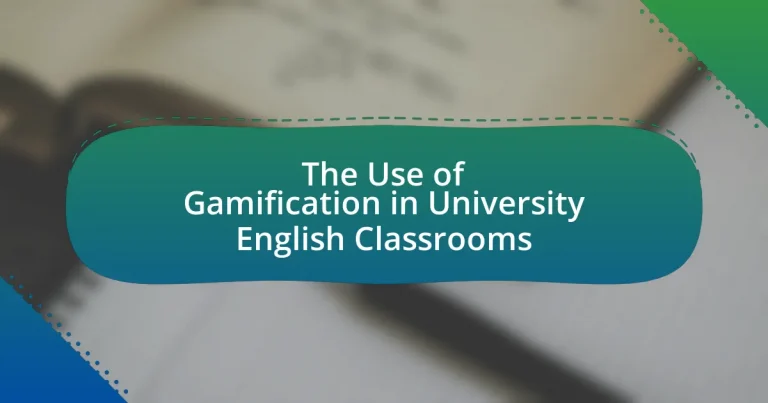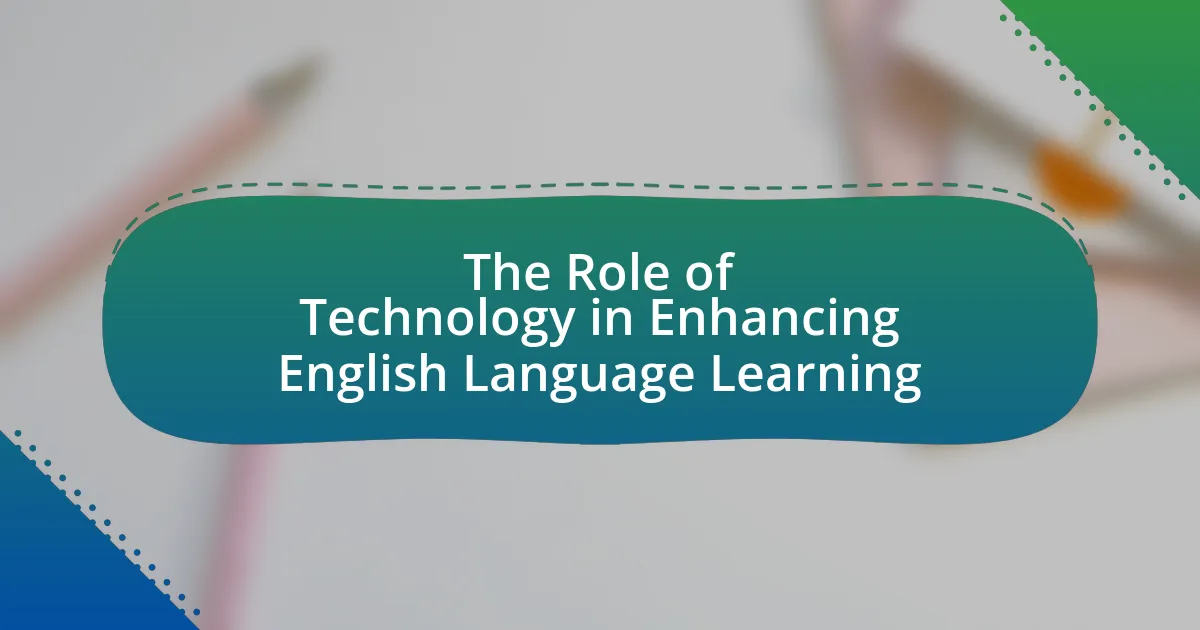The article focuses on the use of gamification in university English classrooms, highlighting its role in enhancing student engagement and motivation through game-like elements such as points, badges, and leaderboards. It defines gamification in educational contexts, discusses its key components, and contrasts it with traditional teaching methods. The article also addresses the challenges students face in learning English and how gamification can effectively overcome these obstacles, leading to improved learning outcomes. Additionally, it outlines best practices for implementing gamification, the tools and technologies that support it, and the benefits of fostering collaboration and competition among students.

What is the Use of Gamification in University English Classrooms?
Gamification in university English classrooms enhances student engagement and motivation through game-like elements such as points, badges, and leaderboards. This approach encourages active participation and fosters a competitive yet collaborative learning environment. Research indicates that gamification can lead to improved learning outcomes; for instance, a study by Hamari, Koivisto, and Sarsa (2014) found that gamified learning experiences significantly increased student motivation and satisfaction. By integrating these elements, educators can create a more dynamic and interactive classroom experience that aligns with contemporary learning preferences.
How is gamification defined in the context of education?
Gamification in the context of education is defined as the integration of game design elements and principles into learning environments to enhance student engagement and motivation. This approach utilizes features such as points, badges, leaderboards, and challenges to create a more interactive and enjoyable learning experience. Research indicates that gamification can lead to improved academic performance and increased student participation, as evidenced by a study published in the “Journal of Educational Psychology,” which found that students exposed to gamified learning environments showed a 20% increase in engagement levels compared to traditional methods.
What are the key elements of gamification in learning environments?
The key elements of gamification in learning environments include game mechanics, engagement strategies, and feedback systems. Game mechanics such as points, badges, and leaderboards create a competitive atmosphere that motivates students to participate actively. Engagement strategies, including storytelling and challenges, enhance the learning experience by making it more immersive and relatable. Feedback systems provide immediate responses to students’ actions, allowing them to understand their progress and areas for improvement. Research by Deterding et al. (2011) highlights that these elements can significantly increase student motivation and learning outcomes in educational settings.
How does gamification differ from traditional teaching methods?
Gamification differs from traditional teaching methods by incorporating game-like elements to enhance student engagement and motivation. Traditional teaching often relies on lectures and standardized assessments, which can lead to passive learning. In contrast, gamification employs interactive activities, rewards, and competition, fostering active participation and a sense of achievement. Research indicates that gamified learning environments can improve retention rates and student satisfaction, as evidenced by a study published in the Journal of Educational Psychology, which found that students in gamified settings scored 14% higher on assessments compared to those in traditional classrooms.
Why is gamification important for university English classrooms?
Gamification is important for university English classrooms because it enhances student engagement and motivation through interactive learning experiences. By incorporating game elements such as points, badges, and challenges, educators can create a more dynamic environment that encourages participation and fosters a sense of achievement. Research indicates that gamified learning can lead to improved retention rates and higher academic performance, as students are more likely to invest effort in tasks that are enjoyable and rewarding. For instance, a study published in the Journal of Educational Psychology found that students who participated in gamified activities scored significantly higher on assessments compared to those who engaged in traditional learning methods. This evidence underscores the effectiveness of gamification in promoting active learning and improving outcomes in university English classrooms.
What challenges do students face in learning English at the university level?
Students at the university level face several challenges in learning English, including limited vocabulary, complex grammar structures, and a lack of practical speaking opportunities. Limited vocabulary hinders students’ ability to express ideas clearly, while complex grammar structures can lead to confusion and errors in writing and speaking. Additionally, many students do not have sufficient opportunities to practice speaking in real-life contexts, which affects their fluency and confidence. Research indicates that these challenges can significantly impact students’ overall language proficiency and academic performance, as highlighted in studies on language acquisition and educational methodologies.
How can gamification address these challenges?
Gamification can address challenges in university English classrooms by enhancing student engagement and motivation through game-like elements. By incorporating points, badges, and leaderboards, educators can create a competitive yet collaborative environment that encourages participation. Research indicates that gamified learning experiences can lead to a 60% increase in student engagement and a 30% improvement in retention rates, as demonstrated in studies by Hamari et al. (2014) in “Gamification: Definitions, Benefits, and Challenges.” This approach not only makes learning more enjoyable but also fosters a sense of achievement, which can help overcome barriers such as lack of interest or low self-efficacy among students.
What are the goals of implementing gamification in English classes?
The goals of implementing gamification in English classes include enhancing student engagement, improving motivation, and facilitating better learning outcomes. By integrating game elements such as points, badges, and leaderboards, educators aim to create a more interactive and enjoyable learning environment. Research indicates that gamification can lead to increased participation and retention of information, as students are more likely to engage with content that is presented in a game-like format. For instance, a study published in the Journal of Educational Psychology found that students exposed to gamified learning environments showed a 34% increase in motivation and a 27% improvement in academic performance compared to traditional teaching methods.
How does gamification enhance student engagement and motivation?
Gamification enhances student engagement and motivation by incorporating game-like elements into educational activities, which makes learning more interactive and enjoyable. This approach leverages competition, rewards, and challenges to stimulate interest and participation among students. Research indicates that gamified learning environments can lead to a 60% increase in student engagement levels, as evidenced by a study conducted by Hamari, Koivisto, and Sarsa in 2014, which found that gamification positively affects motivation and engagement in educational settings. By transforming traditional learning into a more dynamic experience, gamification fosters a sense of achievement and encourages students to actively participate in their learning process.
What skills can students develop through gamified learning experiences?
Students can develop critical thinking, problem-solving, collaboration, and communication skills through gamified learning experiences. Gamification encourages students to engage in complex scenarios that require them to analyze information, make decisions, and work together to achieve common goals. Research indicates that gamified environments enhance motivation and engagement, leading to improved learning outcomes. For instance, a study by Hamari, Koivisto, and Sarsa (2014) found that gamification positively influences user engagement and learning effectiveness, demonstrating that these skills are effectively cultivated in such settings.
How is gamification currently being applied in university English classrooms?
Gamification is currently applied in university English classrooms through interactive activities that enhance student engagement and motivation. Educators utilize game elements such as points, badges, and leaderboards to encourage participation and competition among students. For instance, platforms like Kahoot! and Quizizz are frequently used to create quizzes that make learning more dynamic and enjoyable. Research indicates that incorporating gamification can lead to improved language acquisition and retention, as students are more likely to engage with content when it is presented in a game-like format. A study by Deterding et al. (2011) highlights that gamification can significantly increase student motivation and learning outcomes in educational settings.
What types of gamified activities are commonly used in English instruction?
Commonly used gamified activities in English instruction include role-playing, quizzes, interactive storytelling, and language games. Role-playing allows students to practice conversational skills in realistic scenarios, enhancing their speaking and listening abilities. Quizzes, often conducted through platforms like Kahoot or Quizlet, engage students in competitive learning, reinforcing vocabulary and grammar. Interactive storytelling encourages creativity and comprehension as students collaboratively create narratives, while language games, such as word puzzles and board games, make learning enjoyable and interactive. These activities have been shown to increase student motivation and engagement, leading to improved language acquisition outcomes.
How do educators assess the effectiveness of gamification in their classrooms?
Educators assess the effectiveness of gamification in their classrooms through various methods, including student engagement metrics, academic performance analysis, and feedback surveys. For instance, they may track participation rates and completion of gamified tasks to gauge engagement levels. Additionally, comparing test scores before and after implementing gamification can provide insights into its impact on learning outcomes. Research indicates that gamification can lead to a 20% increase in student motivation and a 15% improvement in retention rates, as highlighted in studies by Deterding et al. (2011) in “From Game Design Elements to Gamefulness: defining” and Hamari et al. (2016) in “Gamification: Definitions, Processes, and Future Research.” These metrics and findings help educators determine the overall effectiveness of gamification strategies in enhancing the learning experience.

What are the benefits of gamification in university English classrooms?
Gamification in university English classrooms enhances student engagement and motivation. By incorporating game elements such as points, badges, and leaderboards, educators create a more interactive learning environment that encourages participation. Research indicates that gamified learning can lead to improved retention rates, with studies showing that students in gamified settings often outperform their peers in traditional classrooms. For instance, a study published in the Journal of Educational Psychology found that gamification increased student motivation by 34% and improved academic performance by 20%. This evidence supports the effectiveness of gamification in fostering a dynamic and effective learning experience in English language education.
How does gamification improve student learning outcomes?
Gamification improves student learning outcomes by increasing engagement and motivation through game-like elements in educational settings. Research indicates that incorporating elements such as points, badges, and leaderboards can enhance students’ intrinsic motivation, leading to higher participation rates and improved academic performance. For instance, a study by Hamari, Koivisto, and Sarsa (2014) found that gamification positively affects user engagement, which correlates with better learning outcomes. Additionally, gamified environments often provide immediate feedback, allowing students to understand their progress and areas for improvement, further reinforcing their learning experience.
What evidence supports the effectiveness of gamification in language learning?
Gamification has been shown to enhance language learning effectiveness through increased engagement and motivation. A study by Hamari, Koivisto, and Sarsa (2014) found that gamified elements in educational settings significantly improve student participation and learning outcomes. Additionally, research by Surendeleg and Purnamasari (2020) demonstrated that gamification in language learning environments led to higher retention rates and improved language proficiency among students. These findings indicate that incorporating gamification strategies can lead to more effective language acquisition in university classrooms.
How does gamification foster collaboration among students?
Gamification fosters collaboration among students by integrating game-like elements into educational activities, which encourages teamwork and collective problem-solving. When students engage in gamified tasks, they often work in groups to achieve common goals, enhancing communication and interpersonal skills. Research indicates that gamification can increase student engagement and motivation, leading to improved collaboration; for instance, a study by Deterding et al. (2011) highlights how game mechanics can create a sense of community and shared purpose among participants. This collaborative environment not only promotes social interaction but also allows students to learn from each other, thereby enriching the educational experience.
What impact does gamification have on student motivation and participation?
Gamification significantly enhances student motivation and participation in educational settings. By incorporating game-like elements such as points, badges, and leaderboards, students experience increased engagement and a sense of achievement. Research conducted by Hamari, Koivisto, and Sarsa (2014) indicates that gamification can lead to higher intrinsic motivation, as students feel more invested in their learning process. Additionally, a study by Deterding et al. (2011) found that gamification fosters a competitive spirit and encourages collaboration among peers, further boosting participation levels. These findings demonstrate that gamification effectively transforms traditional learning environments into dynamic and interactive experiences, ultimately leading to improved educational outcomes.
How do gamified elements influence student attitudes towards learning English?
Gamified elements positively influence student attitudes towards learning English by increasing engagement and motivation. Research indicates that incorporating game-like features, such as points, badges, and leaderboards, enhances students’ intrinsic motivation, making the learning process more enjoyable. For instance, a study by Hamari, Koivisto, and Sarsa (2014) found that gamification significantly improved user engagement and satisfaction in educational settings. This heightened engagement leads to a more favorable attitude towards learning English, as students feel more invested in their progress and achievements.
What role does competition play in gamified learning environments?
Competition in gamified learning environments serves to enhance motivation and engagement among learners. By introducing competitive elements, such as leaderboards or challenges, students are incentivized to improve their performance and actively participate in the learning process. Research indicates that competition can lead to increased effort and persistence, as evidenced by a study published in the Journal of Educational Psychology, which found that students who engaged in competitive tasks demonstrated higher achievement levels compared to those in non-competitive settings. This competitive dynamic fosters a sense of urgency and encourages collaboration, ultimately contributing to a more dynamic and effective learning experience.
What challenges might educators face when implementing gamification?
Educators may face several challenges when implementing gamification, including resistance from students, lack of resources, and insufficient training. Resistance from students can stem from a preference for traditional learning methods, which may hinder engagement with gamified elements. Additionally, educators often encounter a lack of resources, such as technology or funding, which can limit the effectiveness of gamification strategies. Insufficient training for educators in gamification techniques can also pose a significant barrier, as it may lead to ineffective implementation and reduced educational outcomes. These challenges highlight the complexities involved in integrating gamification into university English classrooms.
How can educators overcome resistance to gamification from students or faculty?
Educators can overcome resistance to gamification from students or faculty by clearly demonstrating the educational benefits and aligning gamification strategies with learning objectives. Research indicates that gamification can enhance student engagement and motivation, leading to improved academic performance. For instance, a study by Hamari, Koivisto, and Sarsa (2014) found that gamification positively influences user engagement in educational contexts. By providing evidence of these benefits, educators can address skepticism and foster a more receptive environment for gamified learning experiences. Additionally, involving faculty and students in the design process can help tailor gamification elements to their preferences, further reducing resistance.
What resources are needed to effectively implement gamification in English classrooms?
To effectively implement gamification in English classrooms, educators need digital tools, educational software, and engaging content. Digital tools such as learning management systems (LMS) facilitate the integration of gamified elements like points, badges, and leaderboards. Educational software, including platforms like Kahoot! and Quizizz, provides interactive quizzes and games that enhance student engagement. Additionally, engaging content, such as story-based scenarios and role-playing activities, is essential to create immersive learning experiences. Research indicates that gamification can increase motivation and participation among students, making these resources critical for successful implementation.

What are best practices for using gamification in university English classrooms?
Best practices for using gamification in university English classrooms include integrating game elements such as points, badges, and leaderboards to enhance student engagement and motivation. Research shows that gamification can lead to increased participation and improved learning outcomes; for instance, a study by Deterding et al. (2011) highlights how game mechanics can foster a sense of achievement and competition among students. Additionally, incorporating collaborative tasks and storytelling elements can create a more immersive learning experience, as evidenced by studies indicating that narrative-driven activities enhance language retention and comprehension. Regularly assessing student progress through gamified assessments can also provide immediate feedback, further reinforcing learning objectives.
How can educators design effective gamified learning experiences?
Educators can design effective gamified learning experiences by integrating game mechanics such as points, badges, and leaderboards into the curriculum to enhance student engagement and motivation. Research indicates that gamification can increase student participation by up to 60%, as it taps into intrinsic motivations and provides immediate feedback. Additionally, incorporating narrative elements and challenges that align with learning objectives fosters a sense of achievement and encourages collaboration among students. For instance, a study by Deterding et al. (2011) highlights that well-structured gamified environments can lead to improved learning outcomes by making educational content more interactive and enjoyable.
What strategies can be used to align gamification with learning objectives?
To align gamification with learning objectives, educators should integrate game mechanics that directly support specific educational goals. This can be achieved by designing challenges and rewards that correspond to learning outcomes, ensuring that each gamified element reinforces the desired skills or knowledge. For instance, incorporating quizzes that provide immediate feedback can enhance comprehension and retention of material, as supported by research indicating that timely feedback significantly improves learning outcomes. Additionally, using narrative elements can engage students emotionally, making the learning experience more relatable and effective. By strategically linking game elements to educational objectives, educators can create a cohesive and motivating learning environment that fosters student engagement and achievement.
How can feedback be integrated into gamified activities to enhance learning?
Feedback can be integrated into gamified activities by providing real-time, actionable insights that guide learners’ progress and improve their performance. This can be achieved through mechanisms such as instant feedback after quizzes or challenges, where students receive scores along with specific comments on their answers, highlighting areas for improvement. Research indicates that timely feedback significantly enhances learning outcomes; for instance, Hattie and Timperley’s meta-analysis (2007) found that feedback has a high effect size of 0.73 on student achievement. Additionally, incorporating peer feedback within gamified platforms fosters collaboration and critical thinking, as students learn from each other’s perspectives. By embedding these feedback systems into gamified activities, educators can create a more engaging and effective learning environment.
What tools and technologies support gamification in education?
Tools and technologies that support gamification in education include learning management systems (LMS) like Moodle and Canvas, game-based learning platforms such as Kahoot! and Quizizz, and mobile applications like Classcraft and Duolingo. These tools facilitate interactive learning experiences by incorporating game elements such as points, badges, and leaderboards, which enhance student engagement and motivation. Research indicates that the use of gamification in educational settings can lead to improved learning outcomes and increased student participation, as evidenced by studies showing that students using gamified platforms demonstrate higher retention rates and satisfaction levels compared to traditional learning methods.
What are some popular gamification platforms for English language learning?
Some popular gamification platforms for English language learning include Duolingo, Kahoot!, Quizlet, and Classcraft. Duolingo offers a game-like experience with levels and rewards, making language learning engaging. Kahoot! allows teachers to create interactive quizzes that promote competition and collaboration among students. Quizlet provides flashcards and games to reinforce vocabulary and grammar skills. Classcraft gamifies the classroom experience by turning learning into a role-playing game, encouraging teamwork and motivation. These platforms effectively enhance student engagement and learning outcomes in English language education.
How can technology enhance the gamification experience in classrooms?
Technology can enhance the gamification experience in classrooms by providing interactive tools that engage students and facilitate personalized learning. For instance, platforms like Kahoot! and Quizizz allow educators to create quizzes that incorporate game mechanics, such as points and leaderboards, which motivate students to participate actively. Research indicates that gamified learning environments can improve student engagement and retention rates; a study by Hamari, Koivisto, and Sarsa (2014) found that gamification significantly increases user engagement in educational contexts. Additionally, technology enables real-time feedback, allowing students to track their progress and adjust their learning strategies accordingly, further enhancing the educational experience.
What practical tips can educators follow to implement gamification successfully?
Educators can implement gamification successfully by integrating game elements such as points, badges, and leaderboards into their curriculum. This approach enhances student engagement and motivation, as evidenced by a study conducted by Hamari, Koivisto, and Sarsa (2014), which found that gamification can significantly increase user engagement in educational settings. Additionally, educators should ensure that the game mechanics align with learning objectives, creating a clear connection between gameplay and educational outcomes. Regular feedback and opportunities for collaboration among students can further enhance the gamified experience, fostering a sense of community and competition that drives learning.




